AN/PVS-4
| AN/PVS-4 | |
|---|---|
|
"PVS-4 Starlight Scope" | |
| Type | Passive |
| Place of origin | United States |
| Category | Weaponsight |
| Service history | |
| In service | 1978-present |
| Used by | United States |
| Wars | Gulf War |
| Production history | |
| Designer | Optic Electronic Corporation of Dallas |
| Designed | 1975 |
| Manufacturer | Optic Electronic Corporation of Dallas |
| Produced | 1977 |
| Number built | > 150,000 |
| Variants |
AN/TVS-5, AN/PVS-8, AN/PVS-20, NVS-700, NVS-800 |
| Specifications | |
| Weight | 4.0 lb |
| Dimensions (LxHxW) | 320mm (l) x 120mm (h) x 100mm (w) |
| Resolution (lp/mm) | 32 lp/mm |
| Mode of Operation | Passive |
| II Tube | MX9644 |
| Tube Form Factor | 25mm |
| Field Of Vision | 14.5 degrees |
| Range of Detection | 600m (Starlight) |
| Range of Recognition | 400m (Starlight) |
| System Zoom | 3.6x |
| Generation | 2 |
| Can use these tubes |
ITT FX9860, |
AN/PVS-4 (Night Vision Sight, Individual Served Weapon, AN/PVS-4) is the U.S. military designation for a specification of the first second generation passive Night vision device.
The AN/PVS-4 first saw widespread use during the Gulf War and later some deployment in the Iraq War and has since been replaced by modern third-generation weaponsights.
Introduction
Although passive night vision technology capable of allowing vision under ambient starlight conditions has existed since the 1950s, it was not until the AN/PVS-4 was developed that a practical, high quality device that met military requirements was first made available.
Unlike earlier passive starlight weaponscopes the AN/PVS-4 provided a high quality image without significant distortion, could adjust to changing ambient light conditions, was able to take multiple reticles to operate in many roles and had protective features allowing it to shut down in the event of exposure to bright light, but still recover in time after a muzzle flash for the operator to see the round hit the target.
Using the MX-9644 Image Intensifier tube the AN/PVS-4 became one of the most widely used night vision scopes and has been in active use for more than a quarter of a century.
History
_6th_Platoon%2C_scans_the_horizon_for_the_enemy_during_a_training_exercise_in_the_region.jpg)
Initial engineering development of the AN/PVS-4 was undertaken by Optic Electronic Corporation of Dallas, Texas, in 1975 as a replacement for the Vietnam War era AN/PVS-2 Starlight Scope.
In 1976, the first production contract was awarded for 47,074 units, and first deployed in 1978.
16,927 more units were produced between 1985 and 1989 and 24,046 more units produced between 1990 and 1992.
By 2002, more than 150,000 units had been produced within the United States alone.
Although production has ceased, as recently as 2008 the US military was still obtaining parts to both repair AN/PVS-4s and convert AN/PVS-4s to AN/TVS-5As. It is still presently also upgrading AN/PVS-4s to AN/PVS4As also.
During the Gulf War, the AN/PVS-4 was widely deployed on a variety of weapons. The Gulf War represented the first war in which ground combat operations continued both day and night through the use of night vision devices.
Although more modern equipment was available during the Iraq War, the AN/PVS-4 was still in active use. Production of the AN/PAS-13 thermal weaponsight began in 1996 and production of the AN/PVS-4 ceased entirely by 2002.
Design details
The AN/PVS-4 uses a 25mm screw-type variable-gain Image Intensifier tube. Power is supplied by a single 2.7 volt mercury battery, type:BA-1567/U, BA-5567/U or BA-3058/U although two can be connected. The AN/PVS-4A uses two common AA batteries in a housing designed to fit the AN/PVS-4. AN/PVS-4s still in use today are typically upgraded to AA batteries even if they have not been upgraded to a third generation tube.
MX-9644 Image Intensifier Tube
Much of the success and longevity of the AN/PVS-4 was due to the MX-9644 Image Intensifier tube. To make the tube more usable with simple optics, a second-generation MCP based image intensifier was adapted to an electrostatic inverter, similar to a first-generation image intensifier.
The result was that the tube produced an inverted image, simplifying the optical requirements of any night vision device that used it.
Although not a hybrid tube (Gen1 and Gen2 in the same tube housing) it nonetheless produced a gain of around 20,000 making it suitable for use under starlight only conditions and even overcast starlight conditions in remote locations.
Subsequent Image Intensifier Tube Development
The MX-9644 was later replaced by the MX-11620 Third-generation tube, which is a direct replacement for devices that were designed to use the MX-9644.
The MX-9644 tube was also continued in the form of the MX9644/UV which was a second generation tube although evidence exists that a further hybrid tube (Gen3 tube attached by FO to a Gen1 tube) was developed under this specification to provide far more gain, improved S/N and lower EBI. Hybrid tubes are capable of gains well in excess of 100,000 times. The Stinger Night Sight is a good example of Gen3+1 technology.
The ITT F4849 and ITT F4960 (MX-11619 and MX-11620) were also developed which use a 25mm Gen3 tube. As these tubes were proximity focussed, it was necessary to add a Fiber-Optic inverter to the tube to both extend the optical length of the device and the Gen3 photocathode was also mounted in some cases on a Fiber Optic plate rather than the usual Gen3 glass plate to match the focal point of the AN/PVS-4 optics. These tubes provided significant performance increase in gain but very little in the way of resolution.
Two other tube developments that occurred but were not widely manufactured included optical relays to invert the image both in front and behind a Gen3 25mm tube. This allowed for significant increases in tube resolution and performance over the FO based third generation tubes and involved a lens assembly being housed in a container that matched the MX-9644 tube exactly.
Related development for driving based devices included Fiber Optic expanders that magnified the image and could be retrofitted to driving scopes that also used this tube.
Operation
Operation of the device is through two controls located on the left side of the tube housing.
The lower control is an on/off switch for the image intensifier tube and secondarily controls the gain of the tube, allowing the operator to control the brightness of the image.
The upper control is an on/off switch for the illuminated reticle and secondarily allows the brightness of the reticle to be adjusted.
Elevation and Windage adjustment is made through turrets located on the objective lens. Each click equals 1/4 moa.
Day/night adapter


The AN/PVS4 also has a Day/Night adapter that allows sighting in of the units during the day time or for daytime operation of the sight. Under extremely bright nighttime conditions, it may be necessary to use this adapter.
The adapter consists of three hole sizes spaced evenly around the periphery
These pass by three larger aperture holes and three dark glass lenses to allow for six different levels of light reduction into the scope.
As a result, the AN/PVS-4 can be used in lighting conditions ranging from midday-sun in the desert, through to very-bright-moonlight and high levels of urban lighting.
Under moonlight or lower conditions, the AN/PVS-4 can be used without the adaptor and the ABC or Automatic Brightness Controls will reduce the gain, although the image may be too bright for the reticle to show correctly.
When used, the image of the AN/PVS-4 is reduced and appears somewhat triangular.
Variants
Although not specifically considered "variants" there are a number of other models that share the AN/PVS-4 lineage and often use interchangeable components, including the image intensifier tube.
The addition of a "A" after the model, e.g., AN/PVS-4A, signifies a third-generation image intensifier tube and may be designated either after upgrade or at original manufacture. "A" variants typically use "AA" batteries.
AN/TVS-5
The AN/TVS-5 is an observation scope, although it does come with reticles and can be used as a weaponsight as well. With a larger catadioptric lens and higher zoom level, it is rated with a detection range of over 1 Kilometer with a third-generation image intensifier tube.
AN/PVS-8
The AN/PVS-8 is a large-objective-lens version of the AN/PVS-4 and uses the same tube housing. Intended for mounting or use with tripod, it is an observation device and as such, does not include the reticle or the reticle brightness adjustment.
AN/PVS-20
The AN/PVS-20 is a large-objective-lens version of the AN/PVS-4 intended for mounting on large weapons. It comes with bioptic as well as monocular eyepieces and uses the same tube housing as the AN/PVS-4.
Weighing in at 5.6 Kilograms, it is unlikely to be used on a hand-held weapon but is found on heavy mounted weapons including autocannons and heavy machine guns.
It comes default using AA batteries.
NVS-700
The NVS-700 is the original designation of the Optic Electronics Corp. AN/PVS-4. This model is also manufactured in Iran.
NVS-800
The NVS-800 is the original des of the Optic Electronics Corp. AN/TVS-5. This model is also manufactured in Iran.
Auto NVS-1
Observation version of the AN/PVS-4 without a reticle, manufactured in Iran.
Auto NVS-2
Binocular version of AN/PVS-4 without reticle, manufactured in Iran.
NVS-T 700
Individual Night Vision Sight, With Reticle, manufactured in Iran.
NVS-T 800
Binocular Night Vision scope, based on AN/TVS-5, manufactured in Iran.
IWS NL-84
AN/PVS-4 made in Israel by New Noga Light.
NL-87
AN/TVS-5 derivative made in Israel by New Noga Light.
NL-89
AN/PVS-20 derivative made in Israel by New Noga Light.
Star-Tron
The Star-Tron 426 is a surveillance device designed to make use of the Civilian version of the MX9644 tube, the F4845. It is thought that the F4845 were tubes that did not pass the milspec requirements.
NVM-4
A small surveillance scope intended primarily for Law Enforcement use, that is designed specifically to use surplus MX9644 tubes from AN/PVS-4s that are upgraded to GenIII tubes.
ITT's F4960 Stinger night sight
A direct descendant of the AN/PVS-4 using an advanced GenIII+I F4844 Image tube, it is capable of identifying targets at ranges of up to seven kilometers. It is intended as the sighting mechanism for the Stinger missile. It features as 2.26x zoom and a 23.5 degree field of view.
Reticles
One of the unique capabilities of the AN/PVS-4 that is not available in many other night vision weaponsights is the field-changeable reticles.
By replacing the reticle, the AN/PVS-4 is able to provide service to a wider variety of weapons than any other weaponsight including Squad Automatic Weapons, rocket launchers, grenade launchers, Shoulder-launched Multipurpose Assault Weapons and recoilless rifles.
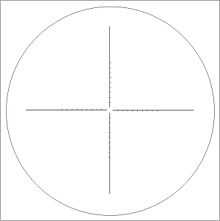
Crosshair
The crosshair is the most basic reticle for the AN/PVS-4 and is available as either a simple crosshair, A mildot crosshair or as an aimpoint crosshair.

M16/M203/M79
The M16 reticle features a range-estimator and a three-point cross-hair that provides an aiming point for close range, 200m and 400m. The same reticle is also used for the M203 and the M79.
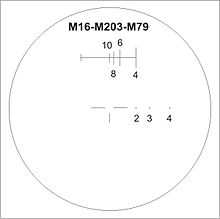
M60/M14/M249
The M60 reticle is similar to the M16 reticle but contains points rathers than crosshairs for 200m, 400m and 600m. This reticle is used for the M14 and M249 also.
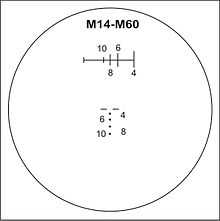
M72A1
The M72A1 reticle contains a rangefinder with marks for 100, 200, and 300 metres.
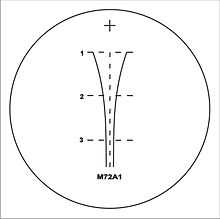
M67
The M67 reticle is similar to the M72A1 reticle, but contains range marks for 200, 400, 600, and 800 metres.
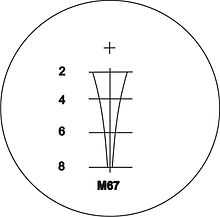
F4960 Stinger night sight
The Stinger reticle is very different in that it is a rear-mounted illuminated reticle -the reticle is built into the tube and positioned on top of the screen so both the screen and reticle are in focus. It also allows red-on-green illumination which makes the reticle stand out. The top circle is the rangefinding circle and the lower three locations are for sighting.
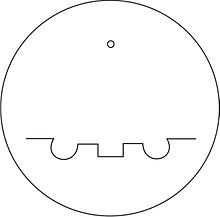
Location of manufacture
The AN/PVS-4 is one of the most widely manufactured night vision sights in the world, with many countries making their own version either under license to the US or as a variant.
US manufacturers
Originally manufactured by Optic-Electronic Corp in Texas, also manufactured by Varo (Litton), ITT and Northrop Grumman and Ni-Tec Inc. in Niles Illinois.
Pakistan
The Institute Of Optronics (IOP) manufactures the AN/PVS-4 and AN/TVS-5 under license.
Germany
Euroatlas manufacture the AN/PVS-4 and AN/TVS-5 Night Vision Sights under license.
Iran
Iran Electronics Industries manufacture the NVS-700(AN/PVS-4) and NVS-800(AN/TVS-5)
Singapore
Thales Optronics Systems manufacture the NVS-700(AN/PVS-4) and NVS-800(AN/TVS-5)
Israel
New Noga Light, a subsidiary of Star Night Technologies, manufactures a range of NVDs including the NL84, NL87 and NL89 variants of the AN/PVS4, AN/TVS5 and AN/PVS20
Alternative use
The AN/PVS-4 is also commonly used for surveillance operations and surplus units are commonly donated to police forces.
There are also surveillance model derivatives specifically designed to use civilian versions of the tube, such as the Star-Tron, which uses the ITT F4845 25mm tube.
Additionally, companies such as AB Night Vision also produce after-market surveillance device housings such as the NVM-4A for law enforcement and civilian use that take surplus military MX9644 tubes.
Summary
Despite being obsoleted by newer technology, especially third-generation night vision, the AN/PVS-4 is still a capable device and still far exceeds the quality of many contemporary civilian devices.
While considered an older scope, it still shows up from time to time as a second-hand or used item at weapon shows and through private sales, although good quality units are still sought after and difficult to come by.
Although the military is phasing this unit out, older devices are frequently donated to police services for reuse and so the AN/PVS-4 is likely to remain in use for some time.
Cultural impact and civilian ownership
Although the AN/PVS-4 is one of the best-known night vision devices, it is not a commonly recognized device. Up until recent times, prohibitive costs and availability limitations on devices such as the AN/PVS-4 resulted in very few items being available outside of the Military.
Because of the limited availability of 25mm image intensifier tubes and housings to civilians, what AN/PVS-4s did become available tended to have well used tubes and as a result, civilians tended to avoid buying them.
The availability of third-generation riflescopes of higher quality for professionals would have provided another option for shooters while the lower cost of first-generation consumer night vision devices would have led to lower end consumers purchasing cheaper imported scopes.
However the AN/PVS-4 does have a reputation for holding zero and being able to withstand high recoil, making it popular amongst enthusiasts who are able to get a reasonable good condition item.
The optics are considered exceptional, even by contemporary standards and the biggest drawback compared to modern scopes is the weight.
Although the AN/PVS-4 has not had a great deal of cultural impact, its legacy of high quality night vision has become a staple of movies and television shows which often do not show real equipment.
As a result, very few people that do not have military, firearm or night-vision experience are likely to recognize one visually.
Notable use
The AN/PVS-4 is used by the Grupo Especial de Operaciones (Special Operations Group, GEO) in Spain.
Formerly a standard weapon of the US Marine Corps
Formerly a standard weapon of Turkey
Use in fiction
- Agent 47 in the popular video game "Hitman" often uses one on his WA2000 rifle
- Kiritsugu Emiya uses one on his Walther WA2000.
- Ryan Cawdor uses the AN/PVS-4 in the literary fiction series Deathlands on a Steyr SSG-70.
- When the forces are deploying towards the end of the movie, a F4960 on a Stinger is the only weapon actually handed out in Transformers: Revenge of the Fallen.
- In Edition 45 of the G.I. Joe comic, Ripcord uses the AN/PVS-4 on a FN FAL in his night-time duel with Zartan.
See also
- Night Vision Device
References
- Much of the information above has been taken from the AN/PVS-4 service manual and operational manual.
- Variant information is taken from datasheets supplied by the manufacturer or published specifications.
- Tube information is taken from public specifications.
- Contract Information and Timeline is taken from Janes
- Stinger sight taken from Janes
- Manufactured in Pakistan by the Institute of Optronics
- Euroatlas Night Vision Sight (AN/PVS-4)
- Singapore and Iran manufacturing reference from Janes
- Parts are still being sourced for repair and maintenance of the AN/PVS-4 as recently as 2008 suggesting this device is still in current use in the US Military.
- New versions of this scope are being manufactured in Iran
